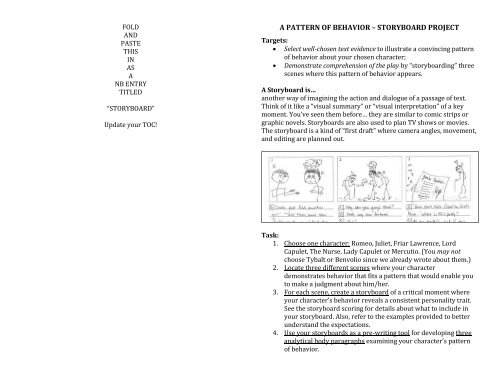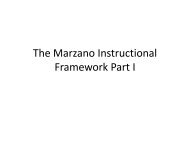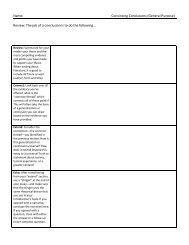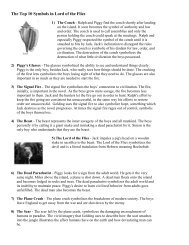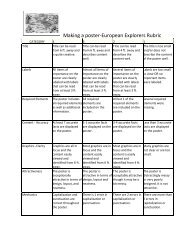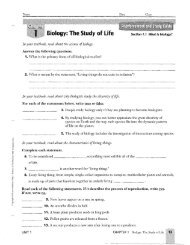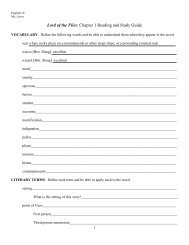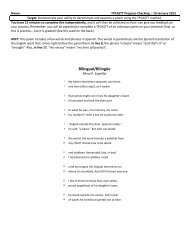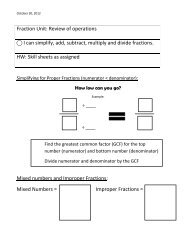Storyboard activity
Storyboard activity
Storyboard activity
You also want an ePaper? Increase the reach of your titles
YUMPU automatically turns print PDFs into web optimized ePapers that Google loves.
FOLD<br />
AND<br />
PASTE<br />
THIS<br />
IN<br />
AS<br />
A<br />
NB ENTRY<br />
TITLED<br />
“STORYBOARD”<br />
Update your TOC!<br />
A PATTERN OF BEHAVIOR – STORYBOARD PROJECT<br />
Targets:<br />
Select well-chosen text evidence to illustrate a convincing pattern<br />
of behavior about your chosen character;<br />
Demonstrate comprehension of the play by “storyboarding” three<br />
scenes where this pattern of behavior appears.<br />
A <strong>Storyboard</strong> is…<br />
another way of imagining the action and dialogue of a passage of text.<br />
Think of it like a “visual summary” or “visual interpretation” of a key<br />
moment. You’ve seen them before… they are similar to comic strips or<br />
graphic novels. <strong>Storyboard</strong>s are also used to plan TV shows or movies.<br />
The storyboard is a kind of “first draft” where camera angles, movement,<br />
and editing are planned out.<br />
Task:<br />
1. Choose one character: Romeo, Juliet, Friar Lawrence, Lord<br />
Capulet, The Nurse, Lady Capulet or Mercutio. (You may not<br />
choose Tybalt or Benvolio since we already wrote about them.)<br />
2. Locate three different scenes where your character<br />
demonstrates behavior that fits a pattern that would enable you<br />
to make a judgment about him/her.<br />
3. For each scene, create a storyboard of a critical moment where<br />
your character’s behavior reveals a consistent personality trait.<br />
See the storyboard scoring for details about what to include in<br />
your storyboard. Also, refer to the examples provided to better<br />
understand the expectations.<br />
4. Use your storyboards as a pre-writing tool for developing three<br />
analytical body paragraphs examining your character’s pattern<br />
of behavior.
Timeline:<br />
Monday, March 18 th: Project introduction and examples<br />
o HW: Select a character and locate your three scenes<br />
Tuesday, March 19 th: Independent Work Time (55 minutes)<br />
o HW: Finish the storyboard of your first scene and begin the second.<br />
Late Start Days, March 20 th, and 21 st: Independent Work Time (70 minutes)<br />
o HW: Finish all three storyboards so you can work on paragraphs in class Friday.<br />
Friday, March 22 nd: Independent Work Time (45 minutes); <strong>Storyboard</strong>s and paragraphs due by 2:55pm on Friday, March 22 nd.<br />
Scoring:<br />
Your paragraphs will each be stored using the standard paragraph scale we’ve used all year.<br />
Your storyboards will each be scored using the following scales (multiplied in Skyward):<br />
Content Appearance<br />
9 Captions blend “modernized” or translated text with some directly quoted lines<br />
from the play.<br />
Captions represent shortened versions of what happened in the text, and<br />
represent the text accurately.<br />
The moment chosen illustrates or highlights a key moment from the focus<br />
character’s actions; clearly shows a behavior that matters.<br />
*Together, the three storyboarded scenes illustrate different behaviors that all<br />
fit a pattern to reveal a character trait.<br />
8 Captions are either too heavily “modernized” or overly quoted, without a blend<br />
or paraphrasing.<br />
Captions represent either too much detail or not enough detail when compared<br />
to the text.<br />
The scene represented conveys the text accurately.<br />
no work submitted by deadline<br />
7 Captions represent what happens in the text, but perhaps miss key moments to<br />
fully represent what happens in this moment.<br />
Captions include some directly quoted text.<br />
6 Captions are generally accurate to the text, but might have some gaps or minor<br />
inaccuracies.<br />
Modernizations might have taken too much liberty, but are still generally<br />
accurate to the text.<br />
All six frames of the storyboard are complete.<br />
Color or creative shading is wisely used.<br />
Different perspectives (“camera angles”) are attempted.<br />
Symbols are used to help communicate concepts.<br />
Attention to detail communicates attitude or setting.<br />
Effort and planning is evident.<br />
The imagery is presented in a clever, creative or unique way.<br />
All six frames of the storyboard are complete.<br />
Color or creative shading is wisely used.<br />
Attention to detail communicates attitude or setting.<br />
Effort and planning is evident.<br />
At least five frames of the storyboard are complete.<br />
Color or shading is used and is appropriate.<br />
Attention to detail communicates attitude or setting.<br />
Might be well planned; doesn’t seem well thought-out.<br />
At least four frames of the storyboard are complete.<br />
Drawings are messy or hard to understand, but with effort a reader can figure it<br />
out.<br />
Color, if used, is random or shows little forethought.<br />
Poorly planned; shows minimum effort or attention to detail<br />
≤5 Captions or incomplete, inaccurate, overly vague or difficult to understand. Four or fewer frames are complete.<br />
Messy, haphazard, disorganized, or shows little effort.<br />
Colors, if used, seem just added on so there is “color.”


